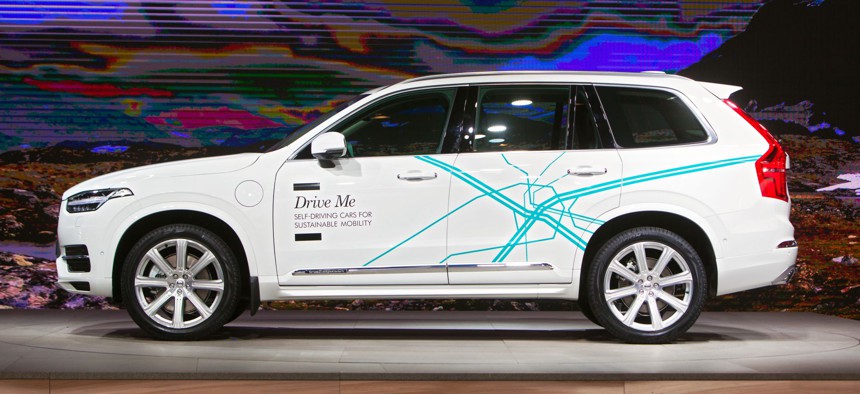Auto Industry Is Wary of State and Local Government Automated Vehicle Laws

A Volvo self driving car on display at the North American International Auto Show media preview January 19, 2017 in Detroit, Michigan. Shutterstock

Connecting state and local government leaders
As more states and localities look to regulate new technology, the “patchwork of state regulations is a concern,” a Volvo vice president tells members of Congress.
WASHINGTON — A group of auto industry leaders testified before Congress on Tuesday that the increasing number of state and local laws regulating automated vehicles is impeding development and deployment—and will ultimately be unworkable.
“The patchwork of state regulations is a concern,” explained Anders Karrberg, vice president of government affairs for Volvo. “Congress should encourage [the National Highway Traffic Safety Administration] to update the Federal Automated Vehicles Policy with an explicit request that states refrain from legislating and regulating self-driving cars.”
The industry representatives agreed with the general sentiment that the federal government must step in and update federal rules to preempt or otherwise incentivize states and localities to set a common national standard for automated vehicle testing and deployment.
The only industry voice offering direct praise for a state regulation came from a General Motors vice president, who noted the “thoughtful” framework put forward by General Motors home state of Michigan. Michael Abelson, GM’s vice president of global strategy, did, however, acknowledge that these varied regulations across states were problematic and urged the committee to “grant the secretary of Transportation authority to grant specific exemptions for highly automated vehicle development.”
Joesph Okpaku, vice president of public policy for Lyft pointed out that “since the beginning of the new year, more than 20 states have filed nearly 60 bills to regulate the testing and deployment of [automated vehicles]. While most of the bills are well-intentioned, it is our position that states should not rush to regulate this technology.”
Karrberg explained that the patchwork of laws will slow the evolution of automated vehicle technology, putting the United States at a competitive disadvantage. “This is a race for jobs,” Karrberg said. “Six years ago, I put you in the lead. Seeing the patchwork, I’m not so sure.”
All witnesses agreed that federal motor vehicle safety standards need to be updated. But U.S. Rep. Debbie Dingell, a Michigan Democrat, pointed out the National Highway Safety Transportation Administration’s process for doing so would take “several years.” The gap between the reality of the federal government’s ability to rapidly promulgate federal rules, and deployment of the new technology clearly creates a catch twenty-two for state and local governments looking to keep their citizens safe.
Volvo’s representative thought the solution was for Congress to take action. “We would not like … to engage in traditional rulemaking because that would stifle development,” Karrberg explained in response to a question from Dingell, who represents a Detroit-area district that includes Ford Motor Co.’s Dearborn headquarters. “This is an area where technology is developing very fast.”
However, there is “no consensus on how safe [automated vehicles] should be before they are allowed on the road,” explained Dr. Nidhi Kalra, co-director for the RAND Center for Decision Making Under Uncertainty. “It’s like allowing teenage drivers on the road. They may not be safe drivers yet but they need good driving experience to become good drivers. In the meantime, they pose risks to themselves and others.”
Several Democrats on the panel did note the importance of state and local regulation. “I always believe that states should be the testbed for innovation to a great degree here,” U.S. Rep. Doris Matsui of California said while questioning witnesses on her state’s efforts to build “a framework for the safe testing and deployment of this technology.”
“We need to determine how states and the federal government can work together to ensure state roads,” U.S. Rep. Jan Schakowsky of Illinois, the ranking member on the Energy and Commerce Committee’s Digital Commerce and Consumer Protection subcommittee, explained in her opening statement.
Tuesday’s committee hearing left unclear how the federal government can close the gap between the years it would take to develop a set of national safety standards to replace the quickly developing state and local government regulations.
In an interview with Route Fifty, Brooks Rainwater, director of the Center for City Solutions at National League of Cities, said: “In order for autonomous vehicles to be truly successful and reach their full potential, cities must work with their counterparts at the state and federal level to ensure travel within—and between—states is seamless. To do this effectively, cities can work to establish partnerships with their counterparts at state departments of transportation and at the federal level.”
As pointed out by Adelson, Americans already live with risk from vehicles. “With 94 percent of fatal crashes caused by human behavior, there is tremendous potential in deploying technology that can do much better.”
In closing his testimony Adelson remarked that “during this hearing alone, another eight people will have died in vehicles on U.S. roads.”
Mitch Herckis is Senior Program Director for Government Executive’s Route Fifty and is based in Washington, D.C.

NEXT STORY: Improving Conservation Planning With GIS to Improve Water Quality





